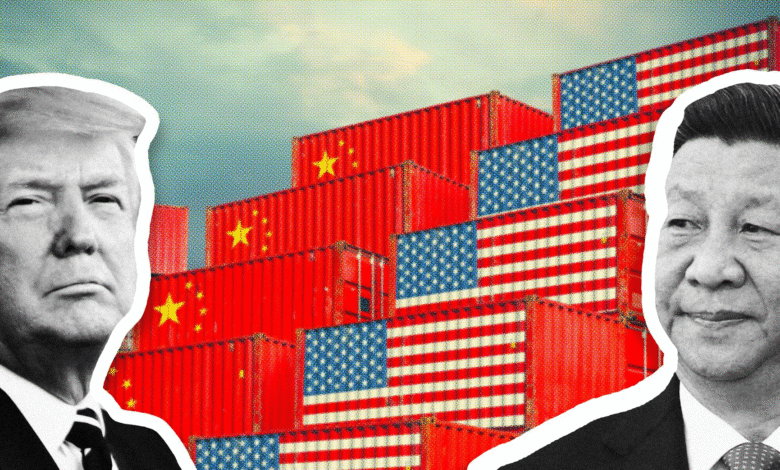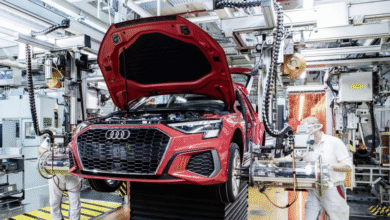Trump’s Trade War: Wall Street Sees Hope Amid Tariff Talks

Trump’s Trade War has recently shown signs of lessening its grip on Wall Street, igniting hope amidst economic unease. As trade tariffs appear to stabilize significantly below the originally proposed rates, market analysts are finding relief from pervasive recession fears. This unexpected turn comes at a time when global economic growth is on the rise, mitigating the inflationary impact of Trump’s aggressive tariff policies. The conclusion of the U.S.-EU trade deal has further solidified this optimistic outlook, indicating that the effective tariff rates may settle in a more manageable 15%-20% range. Overall, while uncertainties remain, the easing of tariff pressures is fostering a more favorable climate for economic growth and financial stability.
In recent months, the ongoing trade tensions initiated by Trump have begun to take on a less daunting appearance, particularly for investors and economists alike. The imposition of trade tariffs, initially feared to spark significant economic disruption, is now being viewed in a new light as a potential avenue towards stability. With the successful negotiation of an U.S.-European trade agreement, market participants are re-evaluating the prospects of a Wall Street recession. Moreover, the observable effects of these tariffs on inflation rates appear to be less severe than initially predicted, suggesting that the U.S. economy may be on a steadier path than previously thought. As discussions continue around trade agreements and their implications, the focus shifts to maintaining economic growth while managing the risks associated with these evolving trade policies.
Understanding Trump’s Trade War and Its Impact
Trump’s Trade War initiated a contentious landscape for U.S. economic relations, characterized by aggressive tariff implementations on foreign goods. Initially, the proposed tariffs raised concerns across financial markets and among global economists, who feared a significant recession. However, the realistic tariff levels that emerged proved to be less severe than anticipated, thereby alleviating some of Wall Street’s recession anxieties. Key to this stabilization was the recognition that while tariffs function as a tax on foreign goods, their long-term impact on inflation and economic growth might be less damaging than previously predicted.
As negotiations persisted, the U.S.-EU trade deal surfaced as a pivotal moment, resulting in a reduction of fears surrounding trade wars. It became increasingly clear that Trump’s administration aimed to navigate through these trade tensions with more caution than originally presumed. Economic forecasts began to adjust, reflecting a more optimistic outlook that predicted slow growth coupled with steady inflation, rather than the catastrophic economic downturn initially forecasted. Consequently, the perception of tariffs shifted from outright threats to manageable adjustments within a complex economic framework.
The Role of Tariffs in Economic Growth
Despite the initial fears surrounding Trump’s Trade War, ongoing assessments suggest that the stabilizing trade tariffs may have a constrained inflationary impact. Economists argue that the current effective tariffs of 15-20% will likely force U.S. businesses to adapt rather than collapse under financial pressure. As corporations adjust prices and supply chains, the adaptation process becomes critical in determining the actual economic growth trajectory. This balancing act could ultimately support a controlled inflation environment while still fostering business expansion.
Moreover, the interplay between tariffs and inflation highlights significant dynamics within domestic economic health. The Federal Reserve has been closely monitoring these developments, as understanding the inflationary impact of proposed tariffs is crucial for future monetary policy decisions. Should growth remain resilient amidst controlled inflation, the Fed may feel more secure in adjusting interest rates favorably to stimulate economic activity rather than stifling it through aggressive tightening. Therefore, growth could continue, despite the imposed tariffs, indicating a layer of resilience within the U.S. economy.
Wall Street’s Response to Trade Tariffs
Wall Street’s fluctuating sentiment towards Trump’s Trade War reflects how market perceptions can rapidly shift based on economic data and trade negotiations. Following the announcement of the U.S.-EU trade deal, analysts noted a sense of relief as the risk of a recession lessened. Financial institutions such as JPMorgan Chase reduced recession probabilities, prompting a more buoyant outlook for investors. This reassessment signals that if tariffs maintain equilibrium without spiraling upwards, market stakeholders may continue to feel confident in their investment strategies.
Furthermore, considerations surrounding the potential risk of a Wall Street recession have fueled debates on the long-term implications of trade tariffs. While some analysts caution about the adverse effects of a prolonged trade conflict, others suggest that a cautious approach may encourage steady economic recovery. As financial markets adapt to the new tariff landscape, maintaining a stable trading environment rather than provoking further trade escalations becomes essential for sustained investor confidence. With the Fed expected to intervene if necessary, market players are closely monitoring the evolving situation.
The Economic Implications of the U.S.-EU Trade Deal
The recent U.S.-EU trade agreement marks a significant shift in the economic landscape, as it promises to reduce the friction caused by Trump’s Trade War. With the effective tariff rates balancing at 15-20%, businesses and economists are optimistic about the persistent pathways to economic growth. Analysts are pointing out that while tariffs inherently present challenges, the trade deal opens opportunities for enhanced cooperation and market accessibility, which could augment U.S. exports and marketplaces.
In an environment where heightened tariffs seem unavoidable, the outlook for the U.S. economy appears increasingly hopeful. The ongoing coordination between U.S. and EU markets could diminish the potential of retaliatory tariffs, which were previously thought to spiral into a broader confrontation. Instead, the conclusion of the trade deal indicates a shift towards more stable and predictable trade policies, paving the way for economic resilience despite lingering pressures in other areas of the global economy.
Navigating Inflationary Risks Amidst Tariffs
Inflationary risks linked to Trump’s Trade War remain a key concern for both economists and policymakers. The initial fears that escalated tariffs would lead to a significant uptick in inflation have been tempered by recent economic data indicating a less severe impact than expected. As businesses have adapted to the new tariff regime, they have generally managed to absorb some costs, thereby averting drastic price increases that could stifle consumer spending.
The upcoming Federal Reserve meetings will further elucidate the relationship between tariffs and inflation, as central bank policymakers consider appropriate measures in light of evolving economic conditions. Sustained inflation control combined with slow yet steady growth suggests that the overall economic environment may continue to adapt effectively to the ongoing challenges posed by tariffs. As inflationary pressures stabilize, this could pave the way for more strategic monetary policy initiatives that encourage expansive growth.
Future Outlook for the U.S. Economy Post-Trade War
The future of the U.S. economy post-Trump’s Trade War hinges on how well businesses can navigate the challenges brought about by tariffs. With the financial landscape showing signs of optimism, many analysts foresee a prolonged phase of gradual growth, contingent on stable tariff rates and effective management of inflation. The complexities introduced by trade policies may push companies to become more resilient and innovative, ultimately fostering a competitive edge in the global marketplace.
Critically, the successful implementation of the U.S.-EU trade deal serves as a foundation upon which future negotiations can build. Analysts argue that continued dialogue and resolution of outstanding trade issues can maintain a trajectory of growth, avoiding the pitfalls that might lead to a recession. Each adjustment made in response to tariffs will contribute to shaping an optimized economic strategy that reinforces the United States’ standing in international trade.
Assessments of Economic Growth Projections
Projections for economic growth amidst the backdrop of Trump’s Trade War remain cautiously optimistic as analysts adjust their expectations based on recent developments in trade agreements. The restoration of some degree of normalcy between the U.S. and European Union stands as pivotal, suggesting that while tariffs may still impose barriers, they are no longer insurmountable obstacles to growth. Many economists assert that understanding these nuances is crucial for forming effective policy responses that align with evolving market conditions.
As we look to the future, the emphasis on sustaining economic growth while managing inflationary pressures takes precedence. Narrows in predictions of recession highlight a collective belief among financial analysts that the two can coexist without causing detrimental economic consequences. With growth continuing, Wall Street appears prepared to embrace the uncertainties of tariffs as long as proactive measures are taken among key economic stakeholders.
Critical Perspectives on Tariff Policy
The discourse surrounding Trump’s Trade War is layered with insights and criticisms regarding tariff policy. Various economists argue that regardless of the perceived benefits, tariffs can disrupt not only trade relationships but also the overall economy’s health. In particular, the debate often revolves around whether tariffs achieve their intended goals or inadvertently escalate trade tensions. The challenge lies in balancing protectionist policies with the need for global economic integration.
Critically, stakeholders must remain attuned to the ramifications that tariffs inflict across industries. As shown in the discussions surrounding the U.S.-EU trade deal, ensuring that tariffs do not hinder innovation and growth will be essential for the broader economy. Prioritizing dialogue over antagonism in trade relationships could enhance both regional and global economic stability, providing the U.S. with a more sustainable pathway forward in the aftermath of trade conflicts.
Frequently Asked Questions
What is the impact of Trump’s Trade War on U.S. economic growth?
Trump’s Trade War has had a complex impact on U.S. economic growth. While initial fears predicted a severe recession due to high tariffs, recent analyses suggest a less dire situation, with tariffs stabilizing around 15-20%. This adjustment, combined with strong global growth and a less than expected inflationary impact, has eased recession concerns significantly.
How have trade tariffs from Trump’s Trade War affected inflation?
The trade tariffs imposed during Trump’s Trade War were expected to increase inflation, but economists have noted a surprisingly modest inflationary impact. As tariffs stabilize at lower levels than feared, such as around 15%, the long-term inflationary effects appear manageable, alleviating concerns about a significant rise in consumer prices.
What is the significance of the U.S.-EU trade deal in the context of Trump’s Trade War?
The recently concluded U.S.-EU trade deal marks a pivotal moment in Trump’s Trade War, as it stabilizes effective tariffs at about 15-20%. This agreement is believed to reduce the immediate risk of severe economic downturns and represents a shift from anticipated trade retaliations towards a more open U.S. market.
How does Trump’s Trade War influence Wall Street’s perception of recession risks?
Initially, Wall Street faced heightened recession fears due to Trump’s proposed tariffs. However, as the effective rates have stabilized and with a supportive global growth environment, financial analysts have reduced recession risk estimates from 60% to about 40%, reflecting a more optimistic outlook amidst ongoing concerns over trade uncertainties.
What might be the long-term economic effects of Trump’s Trade War on U.S. inflation?
While Trump’s Trade War introduced higher trade tariffs that could potentially increase U.S. inflation, current assessments suggest that the overall impact on inflation is less severe than expected. Economists anticipate that stabilizing tariffs and a strong economy may keep inflation under control, although ongoing tariff negotiations could still introduce risks.
Could Trump’s Trade War lead to a Wall Street recession?
While Trump’s Trade War has raised concerns of a possible recession, the latest reports indicate that the risks are diminishing. Current tariff rates, which have settled around 15%, along with global economic resilience, have led analysts to predict slow growth rather than outright recession, although vigilance is necessary due to potential future tariffs.
| Key Points |
|---|
| U.S. tariffs are stabilizing at 15%-20%, easing Wall Street’s recession fears. |
| Global growth and lower-than-expected inflation from tariffs contribute to a more positive outlook. |
| JPMorgan reduced recession risk from 60% to 40%, indicating a more optimistic forecast. |
| Concerns about aggressive tariffs leading to recession are diminishing, though tariffs still pose risks. |
| The upcoming trade negotiations with other partners remain uncertain and could yield higher tariffs. |
| Fed’s interest rate policies will consider the implications of tariffs on inflation and growth. |
Summary
Trump’s Trade War is starting to look less intimidating for Wall Street, as key economic indicators provide a more optimistic outlook. With tariff rates stabilizing and global economic conditions improving, fears of a recession have eased. Though uncertainties remain until all trade negotiations are resolved, the current assessment suggests a moderate impact on the U.S. economy, indicating that the worst may be behind us.



